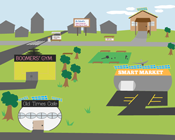Welcome to Elderland
Welcome to Elderland
by Nushin Rashidian
In New Zealand, a company has developed flooring tiles that absorb the impact of falls.
In Japan, a wearable robot suit called Hybrid Assistive Limb (HAL) uses sensors that read nerve signals and tell the suit how to move, assisting people who have weakened muscles or disabilities.
In the United States, the Center for Aging Services Technologies is working on a mattress pad that can assess vital signs like heart rate and breathing, and transmit the data to health care professionals.
In a host of ways, virtually every American community and institution will have to adapt to aging in the next 25 years.
With every baby boomer turning 65 by 2029, the U.S. will have its largest elderly population ever. And with health care costs soaring, and a shortage of professional caregivers already evident—coupled with older adults’ desire to live independently in their own homes—aging-related technologies will be incorporated into peoples’ daily lives, predicts Majd Alwan, director of the Center for Aging Services Technologies.
“All of the studies show they want to age in place,” Jeffery Rosenthal, a Hofstra University gerontologist, says of seniors. “People are putting technologies into place now that are going to help them.”
Thousands of products already in development will make elderly Americans’ activities simpler and safer. The idea is to create communities that don’t isolate older people, Rosenthal says.
Elder-friendly homes will likely incorporate robotics, mechanical helpers that move around the home like much improved and more useful Roombas. They’ll operate in combination with domotics, the wired sensory framework of the home itself; a house will “know” if its occupants are at home or out, for example.
“We’re going to move into an era of smart residential technologies and homes,” says Rosenthal.
Aging technology will change the experience of growing old, both inside the home and outside, in the community.
Imagine an ordinary day in 2035. As you sleep, the aforementioned bed pad — with sensors woven throughout — checks for irregularities in your vital signs. An accompanying electronics box stores monthly data, and brings abnormalities to your and your doctor’s attention. In the morning, your iPhone-like pill dispenser reminds you to take your medicine and alerts your doctor to renew prescriptions. The refrigerator lets you know that the milk is going to spoil in three days, and offers breakfast suggestions to maintain healthy cholesterol.
Community spaces will adapt, too. Machines at the gym will recommend workouts based on your physical needs and limitations. In the supermarket, shelves will rotate so that you don’t have to reach dangerously high or bend uncomfortably low. Much of this adaptation will be made possible by a personalized radio frequency identification chip which stores basic driving, financial and health information on a card. Alwan says the day may come when this chip is inserted in peoples’ thumbs, instead.
One thorny question is how to pay for these new technologies. Much of the cost may fall on taxpayers. The recently-enacted health care bill contains several provisions that may quicken the adoption of aging-related technologies, including portable digital health care records and telemedicine.
In the long term, though, technology could save money. As people age they often suffer from multiple chronic illnesses, requiring a variety of physicians and other health care professionals. Currently, Alwan says, there’s no technology that helps doctors coordinate patients’ care, which leads to repeated procedures, unnecessary hospital readmissions and increased costs.
“Physician A doesn’t know what physician B has prescribed for the same individual,” Alwan said. “That causes medical errors.”
One new provision of the health care reform bill calls for the creation of electronic health records. Medicare and Medicaid will give physicians and hospitals financial incentives to adopt electronic health records and share patients’ information.
Developers of aging technology, encouraged by such prospects, hope that their inventions will become the next household musts. Each year, the American Association of Homes and Services for the Aging holds an exposition that attracts thousands to see what’s new in ideas and technologies. Alwan looks forward to seeing an exercise robot scheduled to be unveiled.
A pilot project of the University of Southern California and Southern California Presbyterian Homes, the robot will provide elderly exercisers with coaching to encourage them to remain active. Eventually, if the concept of an electronic coach catches on, an easily replicated avatar will give instructions from a computer screen, instead.
Even in 2035, however, much of health care will look the same; there will always be a need for face-to-face interactions between providers and patients.
“These shouldn’t be considered replacements,” Alwan says of the technologies. He sees them as a way “to increase the number of available professional caregivers, and to provide additional interventions.”
THIS PACKAGE IN DEPTH
To read about how this story came together and the reporters involved
Click Here.
